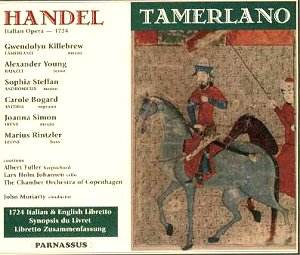Dating from 1970 and with an almost all-American cast
Parnassus has resurrected one of Handel’s most intriguingly cast operas.
There is a semi-heroic tenor part (taken by one of the non-Americans,
the ever splendid Alexander Young - touching nicknamed "Basil"
by the producers of the set) which is in itself unusual as tenor parts
were generally far less centre-stage and indeed were often parcelled
out to older, less heroic characters. As is also often the case the
theatrical heat really starts to generate as soon as the curtain rises
on Act II and here the succession of arias, if not of the consistency
and melodic and expressive depth of, say, Giulio Cesare is still
quite powerful enough. The arias lead with cumulative force and strength
to one of the most remarkable scenes in Handelian opera, the tour de
force suicide of Bajazet, the captive Ottoman King.
First things first. Recorded then in 1970, in Copenhagen,
and last making an appearance I believe on a four disc LP box [Peerless
Oryx] this will invariably come into some kind of competition with more
recent sets. Gardiner and the English Baroque Soloists essayed it on
Erato back in 1985 and Jean-Claude Malgoire with his Grande Ecurie forces
had beaten Gardiner to it two years earlier. So obvious competition
exists, should these still be in the catalogue (and other contenders
along with them). But don’t write off John Moriarty and his now thirty
years plus recording because this is a consistently well sung and splendidly
astute set that still glitters with imagination and insight.
There are some cuts – noted in the booklet where they
are inset in the printed libretto – and a few arias are shorn of their
da capo sections. Nevertheless Moriarty conducts with splendid understanding;
he’s not as crisp as some might like maybe (I think he’s crisp enough
for me) but his authority can’t be gainsaid and neither can the way
in which he keeps the recitative moving, paying especial attention at
all times to the cadential end lines and making sure these match perfectly
with the vocal line. Young was one of the most sheerly impressive and
stylish Handelians of his or anyone’s generation; the bass Marius Rintzler
shines strongly in his smaller role of Leone. Two of the women’s roles
were originally written for castrati - no countertenors for Moriarty
but we do have mezzos Gwendolyn Killebrew and Sophia Steffan to set
the sparks flying. The Asteria is Carole Bogard and she sings with real
eloquence and brightness of timbre. Joanna Simon makes an excellent
Irene.
There are numerous highlights in the opera. Though
the orchestral introduction is measured Moriarty draws out the woodwind
with aplomb. As Tamerlano, Killebrew has a strong and resonant voice;
it rings at the top and has a defined chest voice adding powerful presence
to her characterisation – her aria Vuo dar pace in Act I Scene
II announces singing of real presence. Steffan’s Andronicus is capable
of the most affecting simplicity; her plangent first Act aria Bella
Asteria is an example of pristine delicacy in the interests of greater
characterisation. Carole Bogard colours and shades her voice with sensitivity
in S’ei non mi vuol amar and there is a directness that I find
immensely appealing about her singing here and elsewhere. Young’s assumption
of the captive King occasions a treasurable example of his versatility
as a singing actor; he manages to exude all the wounded pride in the
world with his elegant insouciance in Cielo e terra armi di sdegno.
The succession of Act II arias represents the heart of the opera;
one after the other the singers are generous and expert. Certainly some
of the ornaments are excessive, some of the runs might with justice
have been retaken but the spirit of the work is wholly present and one
senses them working as a genuine ensemble. Young is splendid in A
suoi piedi Padre esangue – real plangency with expressive orchestration
behind him and the beautiful and revealing trio Voglio stragi for
Tamerlano, Asteria and Bajazet is delightfully sprung rhythmically.
The apex of the incremental melancholy is reached with the final Act
II aria, Asteria’s Cor di Padre which Carole Bogard sings with
genuine distinction.
A dispetto, the Act III vengeance aria has been
sung and recorded by the reigning operatic countertenor of the day,
David Daniels. The orchestration is ebullient, Killebrew herself full
of drama – her low notes well sustained, runs powerfully inflammatory.
The orchestral flutes add a piquant touch to the duet Vivo in te
mio caro bene and the whole suicide scene brings out the very best
in Bogard and Young, a kind of extended pieta of intense theatricality
and power. At the end of this long opera a true sense of the tragic
inevitability of Bajazet’s wished-for suicide has been introduced, sustained
and finally played out. For that the applause must go to performers,
whose sense of ensemble is as sound as their vocal abilities are estimable.
Praise too to continuo players Albert Fuller (harpsichord continuo)
and Lars Holm Johansen (cello continuo). The booklet notes are tasteful
and informative with an Italian-English libretto. Far more famous names
than these have fared far less stylishly and well in Handelian opera
on record and praise to Parnassus for bringing this set back to life.
Jonathan Woolf
